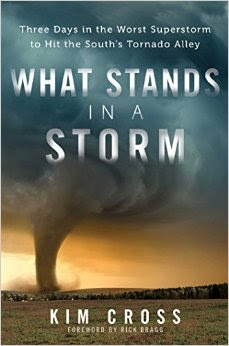Southern History Book of the Month: What Stands in a Storm: Three Days in the Worst Superstorm to Hit the South’s Tornado Alley
 What Stands in a Storm: Three Days in the Worst Superstorm to Hit the South’s Tornado Alley
What Stands in a Storm: Three Days in the Worst Superstorm to Hit the South’s Tornado AlleyKim Cross
Foreword by Rick Bragg
Anyone who has grown up in Alabama knows that tornadoes are a fact of life and it’s best to be prepared for them. Experienced citizens of a strip of territory known as Dixie Alley, similar to the Tornado Alley of the Great Plains, watch the skies for cloud formations and odd colors that signal an impending storm. One report on the so-called Dixie Alley—ironically updated as of 4/26/2011—claims that the Southern corridor of land may be even more of a tornado target than the Great Plains.
As if to underscore that claim, April 27, 2011, ushered in a devastating storm that has gone down in history as one of the worst disasters ever to strike this area. In her book What Stands in a Storm, Kim Cross has compiled years of research and eyewitness reports into a brilliant and terrifying account of the destruction in areas that lay in the path of a nightmarish “wedge” tornado more characteristic of the Great Plains storms than the typical narrow-funnel Deep South twisters. Tuscaloosa was widely discussed in the news coverage because of the enormous size of the tornado as recorded on video at that location, but anyone who lived through that day knows the roll call of other towns and cities—Cordova, Hackleburg, Phil Campbell, and many more—that suffered tornado strikes during the outbreak:
In a tiny town fifty miles north of Tuscaloosa, a woman stood under an awning, taking thoughtful drags from a cigarette. She noticed pink wisps that looked like cotton candy floating incongruously through the air. The sun was shining and the backlit raindrops quickly morphed into pea-size hail that peppered the ground. Wet-cotton clouds snuffed out the sun, and the sky turned green and jaundiced. The woman looked up with a thought she had never had.As a lifelong resident of Alabama, I know the look of that green sky, the strange cotton clouds, and the warning of hail, and Cross’s succinct and poetic narrative style definitely brought back memories of all my unease and fear as I sat in my “place of safety” that day, listening to the radio and wondering where the storm would strike next and if my community would escape.
If fear had a color, this is it.
This week marks the fifth anniversary of the tornado outbreak. Take stock of your supplies, check the batteries in your weather radio, consider downloading a weather app on your smartphone, and have a place of shelter at the ready, for we are definitely in the heart of tornado season. However, as one meteorologist points out in What Stands in a Storm, tornadoes are not necessarily confined to one time of the year:
A great number of highly educated people believe that tornadoes do not occur where they live. Unless they live in Antarctica, they are all wrong. “This comforting myth can kill you,” wrote the meteorologist Chuck Doswell. “Tornadoes have been observed on every continent and in every American state at every hour of the day and in every month of the year.”Be safe, everyone.
For more on Kim Cross and tornadoes:
Kim Cross
Books
A History of Alabama’s Deadliest Tornadoes
A Generational Storm: The Tornadoes That Hit Alabama: April 27, 2011
Day of Devastation: Photos & Stories of Alabama's Deadliest Tornado Outbreak
Mary Ann Ellis
Southern History Department
Central Library
Comments